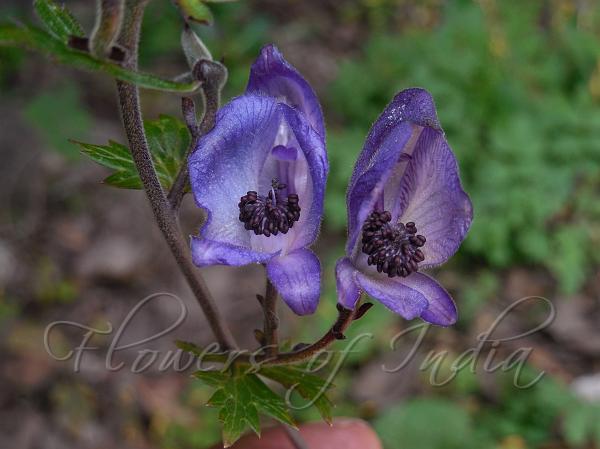|
| Nepal Monkshood |
|

|

| File size | 533614 |
| Original date | 9/19/14 1:49 PM |
| Resolution | 2048 x 1536 |
| Flash | Flash did not fire, auto |
| Focal length | 9.8mm |
| Exposure time | 1/100s |
| Aperture | 4.2 |
| Focus Distance | |
| Metering Mode | Multi-segment |
| Camera make | NIKON |
| Camera model | COOLPIX L620 |
| Sensor type |
|
|
|
|
Photo: |
Botanical name: Aconitum heterophylloides Family: Ranunculaceae (Buttercup family)
Synonyms: Aconitum deinorrhizum, Aconitum laciniatum, Aconitum nepalense
Synonyms: Aconitum deinorrhizum, Aconitum laciniatum, Aconitum nepalense
Nepal Monkshood is a tall hairless, biennial herb
with paired tuberous roots. The daughter tubers are longish conical,
upto 15 cm long and 3.5 cm in diameter at the top. Leaves are
scattered, kidney-shaped or ovate-kidney-shaped, 5-10 cm long, pointed
or blunt, 5-lobed almost to the base. Stem leaves are sharply toothed,
lower ones long-stalked. Flowers are more that 2.5 cm long, bright blue
to greenish blue with purple veins, borne in racemes at branch ends, up
to 45 cm long. Fruit is a capsule bearing numerous seeds. Nepal
Monkshood is found in the Himalayas, from Indus to Kumaon, Himachal
Pradesh, at altitudes of 2400-3800 m. Flowering: July-September.
Medicinal uses: Roots and leaves are used in
rheumatism, rheumatic fever and acute headache. The roots contain 0.9%
total alkaloids, of which 0.51% is pseudoaconitine.
Roots and leaves are used in
rheumatism, rheumatic fever and acute headache. The roots contain 0.9%
total alkaloids, of which 0.51% is pseudoaconitine.
Medicinal uses:
 Roots and leaves are used in
rheumatism, rheumatic fever and acute headache. The roots contain 0.9%
total alkaloids, of which 0.51% is pseudoaconitine.
Roots and leaves are used in
rheumatism, rheumatic fever and acute headache. The roots contain 0.9%
total alkaloids, of which 0.51% is pseudoaconitine. | Identification credit: Krishan Lal | Photographed in Chanshal Pass, Himachal Pradesh. |
• Is this flower misidentified? If yes,